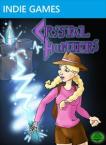Bleed
December 15, 2012 40 Comments
Hey, there’s this game on XBLIG and it looks kind of neat and the demo was okay but I’m not sure if its worth the money. Would you review it?
Sure! Anything for my fans. What game is it?
It’s called Bleed.
Just Bleed?
Just Bleed.
Huh. No funny accents on the letters?
What do you mean?
Well, I mean they could call it BleƐd with a Latin style E. You know, to add a touch of class? Or perhaps Bl€€D with two Euro signs. You know, just to change things up?
Um, no. It’s just Bleed.
Oh. Okay. Seems like a generic name that’s about as memorable as a cup of instant soup, but whatever. I’m duty bound to review games when fans request them and OH SWEET JESUS it cost 400 Microsoft Points?
Yea.
Seriously?
Hey, why do you think we want you to review it?
And that’s where the conversation was left off at. I can see why so many of my readers were requesting a review of this one. The opening level, which I’m sure is as far as the demo goes, is a bit on the generic side. And although the game seems like it could be pretty good, there’s enough unanswered questions that Bleed really is a bit of a high-risk investment, at least as far as XBLIGs go. I mean, for the price of it you could get all five of the top games on my Leaderboard. Survey any number of people and ask them if they’re willing to buy a new product one-for-the-price-of-five with the five being the top five competing products in whatever field. People would look at you like your eyeballs just grew their own noses. They would bill you for the seven seconds of their life you just wasted. And if they’re going to do that, those seven seconds ought to be spent coming up with a better name for your fucking game, especially since you didn’t take seven whole seconds to think it through.
In short, the name sucks and the price sucks harder. Are we clear on that? Good.
Bleed is fucking awesome.
Update, November 20, 2018: Remember, context is everything. In 2012, Bleed was on Xbox Live Indie Games, where 90% of games were 80 Microsoft Points, or $1 each. Games that cost more, unless they were Minecraft clones, didn’t do well. I advocated for a universal $1 price for XBLIGs so as to complete with Xbox Live Arcade games and drive attention to the platform. My position on this has greatly evolved since 2012.

I almost didn’t get to play it. The lightning effects in the opening stage nearly put the kibosh on this review. Thankfully they weren’t as bad as Fez.
Seriously, this is one of the best Xbox Live Indie Games of the year. I didn’t get that vibe out of it at first. The opening stage is, maybe not exactly dull, but it’s not awe-inspiring either. The corny (but delightfully well-written) story centers around Wryn, a spunky pink-haired chick with dreams of being the biggest hero in gaming history. She decides the best way to go about becoming this is to go around killing all the previous top heroes. It’s funny, but it’s not as cool as it sounds. Obviously the guys at Bootdisk Revolution couldn’t use all the real biggest stars in gaming, nor did they even try to make close facsimiles. So you won’t see Wryn bust a cap in a fat Italian plumber named Angelo, or an elfish adventurer named Lenk. The actual bosses seem more like run-of-the-mill bosses that you would expect to encounter in a 2D platformer. It’s a bit disappointing, like hearing about an epic sounding movie and getting all excited only to find out it’s being broadcast on Syfy and starring Billy Zane or Tim Curry.
The first thing you notice about Bleed is movement is smooth and responsive, and that the jumping is going to be a bitch. It’s mapped to the right trigger, because shooting is done TwickS-style and thus having A jump would be impossible. Still, I kind of wish it had been mapped to the less bulky, more analog right-bumper. But what really is awkward about it is how double jumping works. Instead of just flinging yourself in the air a little higher, the character launches like a jet. You can do this twice before landing. It reminded me of Pikachu’s return-attack in Smash Bros. I could never do that fucking thing right either. It’s certainly not a deal breaker, as evidenced by the blow-job I’m about to bestow upon Bleed, but it never felt quite right at any point during the 90 minute main quest.
The jumping physics really are my only complaint. Everything else about Bleed is really astonishing. Levels are fast-paced, well designed, and full of twists and surprises. Retro-nerds will get their jollies from elements borrowed liberally from such games as Mega Man 2. The shooting really is so well done. You have unlimited ammo and no range-limits, giving your character full 360 degree control over firing upon enemies. The starting weapons, a pistol and a rocket launcher, are probably enough to finish the game with. However, you earn points in every level that you can spend in a shop to unlock alternative guns. For some reason, only two can be equipped at a time, which is lame. Also lame is the flame-thrower, which was the first weapon I bought. Go figure. It’s the only weapon of the lot that I found to be ineffectual. Everything else not only works, but experimenting with how to best use them is entertaining and rewarding. And there are just enough guns to unlock to stretch the play time without overly padding things out.
Ultimately, Bleed is a worthy purchase because it’s focused on generating fun. Levels never feel too long. Bosses never feel too spongy. Design never feels unfair. And there’s so many clever ideas at play here that it’s amazing they could keep them all so balanced. Even the writing is sharp, and the big plot twist towards the end was hilarious and awesome. Once you beat the game, extra play modes open that might squeeze more value for your 400MSP. I still think the price is a bit insane, but Bleed is unquestionably a cut above most XBLIGs. But seriously, what the fuck is up with that name? I could find no connection at all with the name and the game. Would it have been better if it had been called Adventures of Pink-Frizzy Haired Homicidal Crazy Chick? Yes, actually it would have. It’s sad that the awful name and prohibitive price will turn off most potential gamers who spot it on the marketplace. It’s enough to make you cry tears of blood.
Ohhhhhhhhhh. So that’s where the name comes from.

 Bleed was developed by Bootdisk Revolution
Bleed was developed by Bootdisk Revolution
400 Microsoft Points said “shave 160 MSP off the price and it might have had a chance” in the making of this review.
Bleed is very much Chick Approved and ranked on the Indie Gamer Chick Leaderboard.






 #4:
#4: 



 #9:
#9:  #8:
#8:  #7
#7 

 #14:
#14:  #13:
#13:  #12:
#12:  #11:
#11:  #20:
#20:  #19:
#19: 
 #17:
#17:  #16:
#16:  #25:
#25: 
 #23:
#23: #22:
#22:  #21:
#21: 
You must be logged in to post a comment.